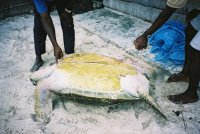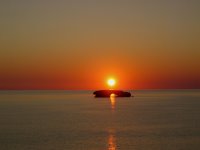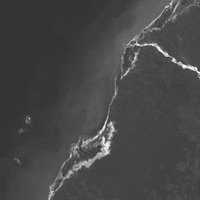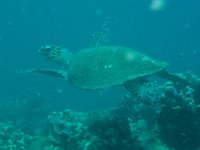I was recently swept off on a spontaneous bird watching adventure with members of the Malagasy bird conservation group ASITY. They were showing some of the best bird watching areas in the region to two tour operators for a local eco-tourism organization in Tana. The group was passing through Andavadoaka on their way to Morombe and asked if I would like to join them for two days of birding.
I met the group in Morombe and we drove to our first destination - Satramalandy (four hours drive east of Morombe). We arrived in the evening and headed out on a night walk to look for nocturnal animals. We had a local guide from the village and all the ASITY members had great knowledge of the local wildlife so it was a great experience for me. We saw iguanas, spiders, geckos and near the end of the walk we saw three Microcebus mettermieri – a very rare mouse-sized species of lemur which was only discovered a year ago. My first wild lemur sighting!
We camped out in tents and awoke very early the next morning to look for birds on a beautiful lake beside the village. Within five minutes I spotted 10 species that I had never seen before including jacanas, herons, terns, coots, and a few duck species. We found the Hottentot Teal, but none of the highly endangered Madagascar Teal.
Later in the morning we drove to Lake Ihotry, the fourth largest lake in Madagascar. The drive through the spiny forest was another wonderful opportunity to spot birds. Our guides used a playback tape which called in another three new species for me. Lake Ihotry is huge and we didn’t have much time to explore but it has high potential as an eco-tourism site with several species of waders and shorebirds.
We headed back to Morombe after lunch and again I was lucky to have the experts identify every species along the way. A long section of the route has rice fields on either side of the road where we saw many egrets, storks, and raptors. In total over the two days I saw 21 new species, several snakes and reptiles plus my first lemurs! Incredible!
We spent the night in Morombe before heading back to Andavadoaka the following morning. Once we arrived I was happy to show the group around Coco Beach and our classroom. I also accompanied them to Nosy Ve, where we spotted a few more birds and found several fragments of elephant bird eggshells which they were all extremely impressed with. We then went to Nosy Hao where I showed off our whale platform. They spent the following day looking around the spiny forest and then took the boat to Tampolove to see some more of the region. Everyone was very impressed with Andavadoaka. They couldn’t believe how nice the beaches are, blue the water is and how friendly the locals are.
Despite a few language difficulties, it was a great way to get to know some Madagascar ornithologists. I have all their contact information along with many invites to spend time in the parks where they work. One man, Julien Ramanampamonjy, is the head ornithologist for the zoo in Tana as well as Madagascar’s representative to the African Bird Club, which I've been invited to join.
Ashley (field scientist)
 The spiny forest contains more than just the amazing baobab trees, it was discovered yesterday. The keen-eyed BV Field Scientist, James Von Squirrelburg, came across this amazing specimen whilst out wandering in the forest. Dissenters were quick to write the animal off as some type of squirrel; however, squirrels are not native to Madagascar. A closer inspection suggests something more akin to a red-ruffed lemur, with exaggerated aposematic (warning) tail circumference, possibly an evolutionary social trait due to the lack of protection afforded by the spiny forest. We will be conducting further research on this exciting new species, and hope to have some more pictures for you soon.
The spiny forest contains more than just the amazing baobab trees, it was discovered yesterday. The keen-eyed BV Field Scientist, James Von Squirrelburg, came across this amazing specimen whilst out wandering in the forest. Dissenters were quick to write the animal off as some type of squirrel; however, squirrels are not native to Madagascar. A closer inspection suggests something more akin to a red-ruffed lemur, with exaggerated aposematic (warning) tail circumference, possibly an evolutionary social trait due to the lack of protection afforded by the spiny forest. We will be conducting further research on this exciting new species, and hope to have some more pictures for you soon.






